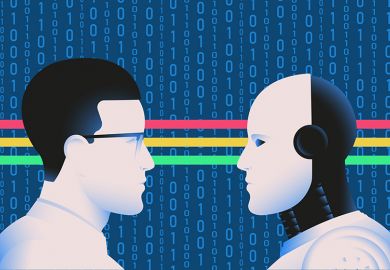The announcement late last year that the DNA of one human chromosome had been sequenced dispersed any remaining doubts about the timescale required to complete the Human Genome Project. It seems almost certain that we shall soon have a reasonably complete sequence of all our genes. The project should tell us a great deal about such fundamental issues as how the genetic information contained within a fertilised egg ensures that it turns into a human being, how we reached our current position on the evolutionary tree, how our brains work and something of the complex interactions between nature and nurture.
The venture has important implications for the future of the medical sciences. It could lead to a better understanding of the 4,000 or more single-gene disorders and enable us to dissect the genetic component of the common killers of western society - heart disease, stroke and major psychiatric disorders. It may even start to give us some hints about the mechanisms of ageing. The novelty of this remarkable project, and the potential commercial value of much of the information it will generate, has bred a new kind of scientific endeavour that involves international research collaborations and close ties between academia and industry. Many of the scientists involved have become increasingly entrepreneurial, either developing major industrial partnerships or establishing their own companies.
This trend is turning out to be something of a mixed blessing, however. On the one hand, the pressures and tensions that have resulted from the evolution of this "big science" have undoubtedly increased the rate of progress, particularly of the Human Genome Project. Indeed, the admirable decision by scientists at the Sanger Centre in Cambridge and their international colleagues to put their DNA sequence data immediately into the public domain, and to do so before their American corporate competitors had time to patent information from the genome project so that it would not easily be available to the scientific community, was a major spur to the project. On the other hand, this highly charged atmosphere has resulted in tensions in the scientific community that have not been encountered before.
Some of the less attractive aspects of modern biomedical science and the Human Genome Project are the subject of this lively book by Paul Rabinow. As a prelude to sequencing the human genome, efforts were made to produce a linkage map of our genes. This is rather like a road atlas that shows us approximately where the main towns are, but provides no information about what lies in between. It offers a series of genetic markers spread throughout the genome that serve as guides for searching for the genes that may be involved in common diseases. In our road map analogy these would be towns that are not on the main map but that are close enough to those that are to make it easy to find them. A prerequisite to research of this type is the collection of data from large numbers of families in which one or more members suffer from these diseases. DNA obtained from such a source provides an invaluable resource for pinpointing the genes that may make us more or less susceptible to such diseases. Because DNA from families of this kind is not easily available to industry, and because of its commercial potential, companies are keen to form links with university research workers and others who have created these databases.
In the 1980s, with remarkable foresight the French genetics laboratory, the Centre d'Etude du Polymorphisme Humaine (CEPH), amassed well-studied families with a view to providing a resource for hunting for the genetic component of common diseases, notably diabetes. In 1993, the CEPH negotiated with an American biotechnology company, Millennium Pharmaceuticals, to initiate a collaborative effort. The gist of this agreement was that the CEPH would supply Millennium with DNA from members of their families; in return the company would offer funding and expertise in new technologies that would accelerate the identification of the putative diabetes genes.
Although at first the French government appeared to approve of this project, early in 1994 and just as the collaboration was getting under way, the government called a halt. In short, it insisted that under no circumstances could the CEPH be permitted to hand out DNA from these French families to the American company. Paul Rabinow spent time in Paris during these negotiations and has attempted to unravel the complex issues that lay behind the decision of the French government. He paints an uneasy picture of the tensions of present-day medical research and of what may be in store for us as the fruits of the Human Genome Project become available. He describes a society that is confused and frightened as to where the genome project may lead, reflecting an intricate interplay of ethical and religious concerns, distrust of the medical sciences, generated in this case by the scandal of the mishandling of screening of blood for Aids, and a feeling of repugnance about handing out DNA from French families for commercial purposes. He also presents an unattractive picture of the ambitions of scientists, the actions of some of whom may have been clouded more by glory and financial gain than the interests of their research field. He is not unsympathetic to their problem, however. They come over as able research workers who are unprepared for the pressures and temptations of commercialism, political expediency and public concerns and prejudices, often based on ignorance of the scientific issues, that typifies much of the biomedical research scene.
Although this book is rather heavy-going due to dense prose and sociological jargon, it tells a fascinating story and one that has important messages for the research community, particularly in the post-genome period. There is enormous pressure on young scientists from government and funding bodies to get into bed with industry. Rabinow's story highlights the dangers of this trend and, more importantly, underlines how ill-prepared our societies are for dealing with the ethical and social issues of the commercial exploitation of human DNA. As emphasised by the speed of progress over the past few months, we do not have much time in which to debate these problems. But if the confusions and tensions of the French scene so vividly portrayed by Rabinow are not to be repeated elsewhere, these issues will have to be faced.
Sir David Weatherall is regius professor of medicine, University of Oxford.
French DNA: Trouble in Purgatory
Author - Paul Rabinow
ISBN - 0 226 70150 6
Publisher - University of Chicago Press
Price - £17.50
Pages - 201
Register to continue
Why register?
- Registration is free and only takes a moment
- Once registered, you can read 3 articles a month
- Sign up for our newsletter
Subscribe
Or subscribe for unlimited access to:
- Unlimited access to news, views, insights & reviews
- Digital editions
- Digital access to THE’s university and college rankings analysis
Already registered or a current subscriber?



